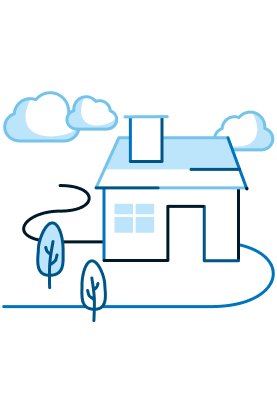Your Step-by-Step Guide to Applying for a Mortgage
Applying for a mortgage requires some research and preparation. In this guide, we cover the steps to take so you're ready to apply for a home loan.

Thinking about buying a home? Whether you’re buying your first condo or upgrading to a house with more room, this article will help guide you through one of the biggest milestones of the journey: applying for a mortgage. Let’s break down the steps.
Step 1: Assessing your financial situation
Before applying for a mortgage, you should assess your financial situation to find out how much you can afford. It’s essential to review your current income, expenses, and outstanding debts.
Know your credit score
Your credit score gives lenders a snapshot of how well you manage your finances and helps them decide how likely you are to pay back a loan on time. It’s calculated with a few different factors including your payment history, the amount of debt you have and the length of your credit history. The credit score range is from 300 to 900, according to the credit bureau Equifax. The higher your score, the more likely you are to get approved for a mortgage.
The minimum credit score requirements to qualify for a mortgage depends on the lender, but as a reference: scores above 725 are very good. If you have a low score, it may be harder for you to get approved for a loan, mortgage, or credit card. To keep your credit score in good shape, it’s best to stay on top of your monthly payments since this plays an important role in keeping your credit score healthy. Find more tips on how to improve your credit score before applying for a mortgage.
Calculate DTI
Your debt-to-income (DTI) ratio – or the percentage of your monthly income that goes toward paying off your debt is an important metric that lenders review when deciding if you qualify for a mortgage. It’s calculated by dividing your monthly debt obligations – like credit card and loan payments – by your monthly gross income (what you earn before taxes and other deductions). The lower your DTI, the better, since it shows lenders you’re more likely to manage your mortgage payments comfortably.
Lenders typically look at two types of DTI ratios:
- Gross debt service (GDS) ratio: This measures how much of your income goes towards housing costs, including mortgage payments, property taxes, and heating. Ideally, your GDS ratio shouldn’t exceed 39% of your gross household income.
- Total debt service (TDS) ratio: This includes your housing costs plus any other debts you may have, like credit cards or loans. Lenders typically look for a TDS ratio that doesn’t exceed 44% of your gross household income.
Budget for mortgage payments and additional costs
When it comes to a budget, don’t forget to factor in additional expenses like insurance, maintenance, repairs, and renovations. The idea is you want to have some breathing room in your budget so you can comfortably afford your mortgage payments and more.
Pass the mortgage stress test
Canadian home buyers need to pass a mortgage stress test as part of the mortgage application process. Conducted by your lender, the test ensures that that you could still comfortably handle your mortgage payments if interest rates were to go up. The minimum qualifying rate is 5.25% or the rate you qualify for plus 2% – whichever is highest.
Although the mortgage qualifying rate is meant to protect the Canadian housing market, it can also affect how much home you can afford, meaning you might need to lower your budget or save for a larger down payment on your mortgage. Speaking with a mortgage specialist can help you understand your options and make a plan that works for you.
Prepare ahead of time
Before you apply for a mortgage loan, it helps to get a few things in order. That way, you’re in a good position when it’s time to send in your application.
- Improve your credit score by making payments on time and reducing your debt.
- Keep your income stable by avoiding major changes to your employment.
- Pay down your existing debt to lower your DTI.
- Gather your documents, such as pay stubs, tax returns, I.D. and bank statements.
Step 2: Saving for a down payment
Your down payment plays a big role in the home-buying process. It’s the portion of the home’s purchase price that you put in upfront, and the mortgage covers the remainder of the cost. How much you need to save for a down payment depends on the purchase price of your home.
| Your home purchase price | Minimum down payment required |
|---|---|
| $500,000 or less | 5% of the home purchase price |
| $500,000 to $1,499,999 | 5% of the home purchase price up to $500,000, 10% of the home purchase price above $500,000 |
| $1.5 million or more | 20% of the home purchase price |
These are the minimums you must meet for your down payment. But remember, it’s just the minimum. A substantial down payment can put you in a solid position when you apply for a home loan.
Even if you meet the minimum down payment, you may still need to pay for mortgage loan insurance. This insurance protects your lender in case you can’t make your mortgage payment and is generally not mandatory if you’re able to put down 20% or more of your home’s purchase price. But anything less than that typically does require mortgage loan insurance.
While down payments are a significant part of buying a home, it’s important to remember that you will also have closing costs to consider when you apply for a mortgage.
To help save for a down payment, you can look into a First Home Savings Account (FHSA). These accounts are available to first-time home buyers and all allow you to make a tax-free withdrawal when you make your purchase.
Step 3: Understanding the different types of mortgages
When you’re applying for a mortgage, one of the first things to think about is the type of interest rate you want: fixed or variable. Let’s review the pros and cons of each.
| Details | Fixed-rate mortgages | Variable-rate mortgages |
|---|---|---|
| Features |
|
|
| Considerations |
|
|
Step 4: Research and compare mortgage lenders
Applying for a mortgage is a big step and likely the biggest loan you’ll ever take out. That’s why it’s crucial to do your research and compare different mortgage lenders. Finding the right fit can make a big difference – not just on your rates and terms, but also on features like prepayment privileges and overall experience.
After comparing between mortgage lenders, you can compare interest rates, terms, mortgage products available, and any perks. You can also look into customer reviews and see if it’s possible to apply for a mortgage online. Ultimately, you want to find a mortgage product that suits your needs and offers you a competitive interest rate.
Step 5: Pre-Qualifications and Pre-Approvals
Once you choose a mortgage lender, you can consider getting pre-qualified and/or pre-approved. Pre-qualification is typically the first step you can take to get a quick estimate. On the other hand, mortgage pre-approvals take a deeper dive into your finances and give you an estimated mortgage amount for what you can afford.
| Mortgage pre-qualification | Mortgage pre-approval |
|---|---|
| Quick estimate of what you may afford | A detailed estimated mortgage amount |
| Soft credit check (no impact to your credit score) | Hard credit check |
| Brief snapshot of your finances | More comprehensive look at your finances |
Pre-qualification is helpful if you’re in the “just looking” phase and know you want to buy a home eventually. Pre-approval is great if you’re already searching for homes and ready to buy. Getting pre-approved shows sellers that you’re serious and that you’re ready to buy. It also lets sellers know that you have a financing option available to make it happen.
Step 6: Securing your mortgage
When you’re ready to apply for a mortgage, you’ll need to complete the entire application with the lender of your choice. To help speed things up, make sure you’ve completed all parts of the application, including any required supporting documentation. After your application is submitted, it will be reviewed by an underwriter.
You’ll get a comprehensive loan estimate with a breakdown of costs, fees, rates, and payments. As part of the process, there will also be a home value appraisal to confirm the market value of the home you’re buying. Once complete, you’re ready to make an offer on the home. Work with your real estate agent to negotiate or accept the purchase price once you hear back.
The bottom line
Getting a mortgage might seem complicated at first, but by breaking things into steps, it becomes a lot more manageable. From understanding your credit score, to comparing lenders, each step brings you closer to unlocking the door to your new home. Take your time, ask questions and don’t be afraid to lean on experts along the way.
Curious about how much you can afford? Try our mortgage affordability calculator. If you feel ready, you can also get pre-approved or pre-qualified at your own pace.
FAQs
How much mortgage you can afford depends on your income, debt obligations, and other factors. You can use our mortgage affordability calculator if you’re just thinking about it, or get pre-approved if you’re more serious about buying a home.
A good credit score to buy a home depends on the lender, but having a higher credit score can help. As a reference: scores above 725 are very good.
To prepare for a mortgage application, you’ll need your government-issued I.D., pay stubs, bank statements, and tax returns. You must provide these to prove your identity, employment, and income.
While it’s not a requirement to be pre-approved or pre-qualified before applying for a mortgage, it’s a good idea. Getting pre-approved helps move you through the home-buying process quicker and let’s you know how much home you can afford.
As you explore mortgage prepayment options, one key thing to consider is whether your mortgage is open or closed. The right choice for you comes down to what you want from your mortgage and how much flexibility you’re looking for with your payments.
With an open mortgage, you can pay off all or part of your mortgage anytime without facing prepayment charges. The trade-off is that interest rates are usually higher than what you’d get with a closed mortgage.
On the other hand, a closed mortgage comes with limited prepayment flexibility. If you’re looking to pay more than your allowed prepayment amount, you may have to pay a prepayment charge. However, closed mortgages usually offer lower interest rates.
Ready to get started?
Our mortgage experts can help you review your options and take the next step.




